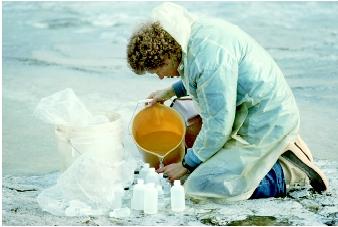Earth's Interior, Water in the
Water is found in different physical states at different levels below the Earth's surface. At shallower depths, it is a liquid occurring in fractures and in the pore spaces of rocks and unconsolidated materials. At greater depths, it is found as a gas within pore spaces, at minerals boundaries, and even locked within a part of the crystalline structure of the minerals themselves.

Water States
The major source of trapped water at shallow depths is rain and melted snow that infiltrates the ground and moves through the interconnected pore spaces as groundwater . Groundwater found at greater depths, about 300 meters (approximately 1,100 feet), generally has been below the surface for hundreds to thousands of years. Below a depth of about 750 meters (approximately 2,500 feet), the amount of groundwater gradually, though irregularly, diminishes.
Water that is present in pore spaces or around mineral-grain boundaries at greater depths will occur as a vapor due to the high temperatures. The pore spaces found at this depth are usually small and are no longer well interconnected. At that depth, water may also be found locked in the crystal structure of minerals as fluid inclusions , or in hydrous minerals as molecular water, hydroxyl anions, or protons.
Many scientists believe that the existence of the Low Velocity Zone (LVZ) is due to the presence of partially molten rock. The LVZ is described as a region approximately 60 to 150 kilometers (37 to 94 miles) deep beneath oceanic plates where earthquake wave velocities are noticeably slower. The LVZ occurs because the presence of water lowers the melting temperature of mantle rock, producing a partially molten region.
Influence of Water
The presence of water in the pore spaces at great depths within the Earth plays a role in metamorphism . Water enhances metamorphism by increasing the rate of chemical reactions, by increasing the distribution of heat, and by forming water-bearing minerals. Under dry conditions, most minerals react slowly, but when water is present, reaction rates increase, mainly because ions can move readily with water through the rock, thereby increasing the rate of chemical reactions and the formation of new minerals.
Metamorphism can also release water. This can occur either through a chemical reaction that produces water, or when water molecules previously locked in the crystalline structure of the minerals are released. This water, along with dissolved ions from the host rock, is sometimes carried away through systems of rock fractures. As this extremely hot, ion-rich water travels these cracks, it reacts chemically with the surrounding rock. This produces a distinct type of metamorphism called metasomatism ("meta" meaning change and "soma" derived from the Sanskrit word for juice ). During metasomatism, water temperatures can be 250°C (482°F) or higher. Such fluids are called hydrothermal solutions. ("Hydro" is the Greek word for water and "thermal," from "therme," is the Greek word for heat ).
Metamorphism may also have its own "seismic signature." A different type of earthquake activity has been noted in subduction zones. The activity is more like that associated with volcanoes; the signals may record the effect of metamorphism and associated fluids in subducting plates.
Hydrothermal solutions form veins by depositing dissolved minerals as the solution flows through the cracks in the rocks. By altering existing rocks, hydrothermal solutions play an important role in the formation of ore deposits. Probably more mineral deposits have been formed by deposition from hydrothermal solution than by any other way. Examples of rich hydrothermal ore deposits include the famous tin-copper-lead-zinc veins of Cornwall, England; the gold-quartz veins of Kalgoorlie, Australia; and the tin-silver veins of Potsi, Bolivia.
SEE ALSO Groundwater ; Hot Springs and Geysers ; Plate Tectonics ; Springs ; Volcanoes and Water .
Alison Cridland Schutt
Bibliography
Monroe, James S., and Reed Wicander. Physical Geology: Exploring the Earth, 2nd ed.St. Paul, MN: West Publishing Company, 1995.
Skinner, Brian J., and Stephen C. Porter. The Dynamic Earth: An Introduction to Physical Geology, 4th ed., New York: John Wiley & Sons, 2000.
WATER LEVELS IN WELLS AS EARTHQUAKE DETECTORS
Earthquakes result from rock deformation, typically faulting. Regions of rock around an active fault are stretched, whereas other regions are squeezed. This squeezing and stretching causes the rock volume and therefore its pore spaces to be increased or decreased.
A decrease in pore space size will squeeze confined groundwater into a nearby water well, causing the water level in the well to rise. An increase in pore space size will cause water to be drawn from the well into the surrounding rock, thereby yielding a water-level decrease in the well.
Consequently, careful measurement of water well levels near an earthquake can indicate how stress fields change after seismic events. This is important for understanding how kinematic stresses change, and it helps geologists measure the probability of future earthquakes in that region.
Comment about this article, ask questions, or add new information about this topic: